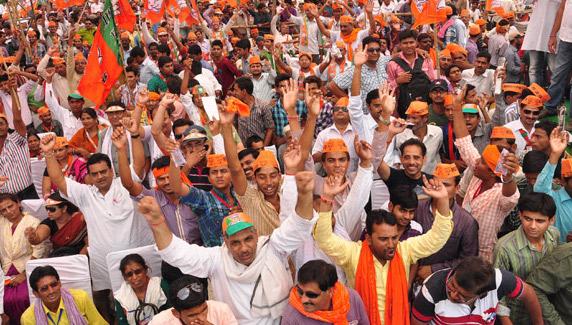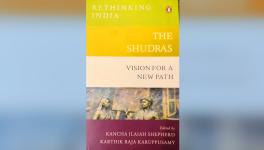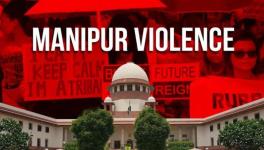The Real Message From Uttar Pradesh

The Real Message From Uttar Pradesh
PUNE: A lot has been written about the results of the UP assembly elections which seem to have confounded the critics as well as the participants in equal measure.
Much of what has been said is more of a description than analysis. Take for example, the belated discovery, by participants as well as commentators, of a 'Modi Wave’ or a ‘Modi March’.
Or for that matter, the tribute paid by a veteran opposition leader that PM Modi is “the most dominant figure in politics today”.
Leaving aside the obvious wisdom of hindsight that inspires such comments, they hardly go beyond simply describing the outcome. Moreover, even that description is questionable. How is it that 'the wave' did not touch the shores of Punjab, Goa or Manipur although the elections in these states were held in the same time-frame? Why is it that the most dominant politician failed to dominate the outcome in those states?
At another level, the analysis such as is presented, barely skims the surface. For example, it has been stressed that BJP/ RSS have well-oiled large cadres which Congress/ Regional parties do not possess. And that gave a handsome advantage to the BJP.
It is also argued, and rightly, that 'communal polarisation' and 'social engineering' which the BJP succeeded in bringing about influenced the outcome decisively. But there is hardly anything new in either the presence or absence of cadres in different political parties. Equally, the 'social engineering' and the 'communal polarisation' projects of BJP are not new. They are part of the long- term socio-political strategy devised by the Hindutva forces who exploit them tactically in the elections almost invariably.
More specifically, and a little differently put, the question that needs to be probed is: Why did they succeed in UP in 2014 and 2017, but, say, not in Bihar in 2015? And in answering that, one should steer clear of taking recourse to the obvious ( eg. the presence or absence of Mahagathbandhan) and try to understand what is happening in the wider context and a longer time-frame.
The project of nation-building commenced with the first War of Independence in 1857. It was carried forward by the freedom movement represented by the Indian National Congress. The project was founded in anti-colonialism. It sought to weld together traditionally divided and unjust Indian society and polity across the sub-continent. Divisive religious, regional and social identities were sought to be moderated, if not superseded, by means of an appeal to an overarching, modern, pan-Indian and more just Idea of India.
The project had its adversaries. Besides the overt suppression by the colonial power, it faced internal resistance from those indigenous elements who sought to fashion Indian nationhood as a replica of the European concept, based on religious and cultural identity and in antagonism of ‘enemy within’. This was a welcome development for the colonial rulers who encouraged and supported it.
The net result was that the modern, pan-Indian project received a major set -back in the Partition which accompanied Independence. The resilience and inherent viability of the project reasserted itself in the adoption of the Constitution upholding the basics of the Idea of India. However, the failure of the Indian polity to transform itself into a truly egalitarian and just social and economic order has brought to surface the limitations and weaknesses of the project as it has been executed.
The weakness of the transformative agenda of the project is most evident in the gross failure in handling the question of Indian peasantry. Equally, it is manifest in the adoption of the neo-liberal policies for accelerating ‘growth’ which has no solution in sight to burgeoning problem of unemployment. On both these counts, all the structured political parties have to share the blame.
The conjuncture is most conducive to reassertion of identity politics. Emergence of politics of ‘social justice’ based simply on the identity of caste is an example. But this soon reaches its limits as the ‘growth’ continues to be jobless as well as iniquitous. The vested interests who are the beneficiaries and promoters of this kind of ‘growth’ find it convenient to play the card of ‘cultural nationalism’, on the one hand, and ‘social engineering’, on the other. The former seeks to mask the prevalent social and economic injustice and inequity and promote a majoritarian identity encompassing smaller identities. The latter seeks to take the caste- identity politics of ‘social justice’ to its logical end of unravelling.
The Modi-Shah duo implemented this strategy in U.P. elections. And they succeeded because no credible alternative narrative was forthcoming from those opposing them.
The more or most backward among other backward classes are but large chunks of marginal and small peasantry who are the worst affected by the present model of growth practised by all political parties including BJP as well as the regional parties like SP and BSP.
In the circumstances, counter- mobilisation of these sections, on the promise of sharing the state- power for whatever benefits it may offer in the short run, against those caste-identity parties who ruled so far, provides a strong appeal. Moreover, the appeal of a ‘wider identity’ based on cultural nationalism has some attraction for those who have been excluded or marignalised by the major “social justice” parties.
The appeal of cultural nationalism, which is but another name for ‘communal polarisation’ has a catchment which includes the better- off sections, the upper castes, the so-called ‘aspirational’ youth and, of course, the die- hard Hindutva legions. The counter to this offered by the ‘secular’ plank has no popular appeal for the majority community as it once had in the hey-days of the freedom movement when the anti-colonial struggle required a modern, united political front.
Moreover, the practitioners of the secular politics, the Congress and regional parties in UP, have not covered themselves with glory when it comes to communal riots or covert discrimination or opportunist alliances with communal forces. The popular appeal of secularism thus gets reduced in practice to the religious minority which is genuinely and deeply anxious about its safety and welfare under the regime of cultural nationalists. And this is precisely picked up by the BJP to malign the secular politics as politics of appeasement of minority. The majority community no longer under the spell of secular politics of freedom movement finds the appeasement idiom plausible.
There was no credible alternative political narrative in UP. Nor even a credible leadership offering a short- term political alternative, albeit without any transformational agenda, as it happened to be the case in Bihar in 2015. The result is there for all of us to see.
The results of UP assembly elections are important not only because UP is the ‘heart of India’. Or because they clear the way for Modi in 2019, as even some opposition leaders have said. They are important because they expose the basic malady of Indian politics unambiguously and boldly. On the national scale, there is no alternative political narrative articulated by the political opposition. And there is no credible political alternative in sight, even without a transformative agenda.
What is worrisome is not so much that PM Modi may get his way in 2019. It is the inherent unviability of that brand of politics and policies in our situation. It is more than just non-viability.
The explosive potential of the peasantry in crisis cannot be overstated. Nor that of the burgeoning legions of youth seeking jobs with dignity. Today they could be won over by the slogans of cultural nationalism and the tactics of social engineering. But it would not be long before the hollowness of the strategy is exposed spreading massive discontent and unforeseen, anarchic upheavals.
No nation- state can survive long, let alone prosper, with a huge population of 18 crores of its people sulking as second- class citizens and feeling insecure. No amount of ‘nationalist’ sloganeering can eradicate that fact. No amount of force can alter that fact. The only viable politics for India is that based on the inclusive and modern values of Equality, Liberty, Fraternity and Justice. We need to reinvigorate these fundamentals enshrined in our constitution and reconstruct the narrative of nation-building.
The obvious starting point is that of the First War of Independence of 1857. The peasantry constituted the core and the peasant-soldiers in East India Company’s army constituted the striking phalanx of that mass struggle against the onslaught of colonialism then. The small and marginal peasantry of today being pauperised and the present generation of youth being denied work opportunities with dignity and fulfilment will now constitute the core and striking phalanx of the democratic struggle against the neo-liberal policies and the model of growth imposed by those policies.
On the issue of agrarian crisis as well as that of unemployment, there are no solutions within the framework of neo-liberalism. And no easy solutions even otherwise. Eventually we have to move towards the change of mode of production, both in the agrarian and industrial economy.
A beginning can be made by transition to cooperative farming as a peoples’ movement. A large scale programme of input- procurement and processing of output in agricultural sector, supplemented by an equally massive programme of watershed planning, water and soil conservation, social forestry, building rural infrastructure and, above all, a comprehensive provision of social and economic security for all, will provide immense work opportunities to our youth.
This would have to be supported by appropriate industrial and trade policies at the national level. It is obvious that these initiatives imply the negation of neo-liberal policies and rejection of the model of growth that flows from those policies. With the retreat from globalisation and multilateralism in industrial countries, sustenance of neo-liberal policies in the developing world would become far more difficult. That should provide a niche for re-orienting current policies and moving away, step by step, from the policies of neo-liberalism.
In other words, the political crisis underlined by the UP Elections calls for alternative narratives in the spheres of politics and political economy. The crisis can be perhaps postponed a while, if a credible political alternative is cobbled together, which is what seems to be the main pre-occupation of political practitioners. But that would not alter the underlying unviability of that kind of politics. Indeed it may simply add to the explosive potential of the underlying crisis.
The solution lies in establishing an alternative political narrative and mobilising the peasantry and the youth around it.
(S.P.Shukla is retired from the Indian Administrative Service as former Finance Secretary)
Image Courtesy: commons.wikimedia.org
Disclaimer: The views expressed here are the author's personal views, and do not necessarily represent the views of Newsclick
Get the latest reports & analysis with people's perspective on Protests, movements & deep analytical videos, discussions of the current affairs in your Telegram app. Subscribe to NewsClick's Telegram channel & get Real-Time updates on stories, as they get published on our website.























